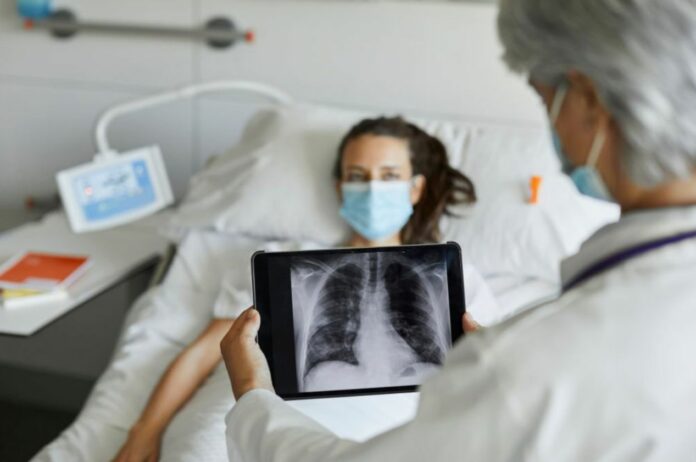Researchers have innovatively turned adult skin cells into a liquid solution that, when administered nasally, can enhance the body’s immune response and alleviate inflammation and tissue damage in the lungs caused by infections or trauma.
Adult Skin Cells Offer a New Way to Reduce Inflammation, Tissue Damage in the Lungs Caused by Infection
New research indicates that therapeutic nanocarriers derived from adult skin cells have the potential to alleviate inflammation and tissue damage in mice with lung injuries. These findings suggest a promising treatment approach for individuals with severely injured lungs caused by infection or trauma.
Scientists conducted experiments using cell cultures and mice to demonstrate the therapeutic efficacy of these nanoparticles, which are extracellular vesicles resembling the ones found in the bloodstream and biological fluids of humans. These vesicles serve as messengers between cells.
The goal is to administer a solution containing these nanocarriers through the nasal passage, allowing them to reach the lungs. This approach could be used to treat acute respiratory distress syndrome (ARDS), a common cause of respiratory failure that often necessitates ventilator support. In ARDS, uncontrolled lung inflammation overwhelms the immune system, preventing immune cells from addressing the underlying cause of the damage.
According to Natalia Higuita-Castro, senior author of the study and an associate professor of biomedical engineering and neurosurgery at The Ohio State University, these extracellular vesicles offer an alternative therapy for ARDS, providing a chance for the patient’s own immune system to fight back. The imbalance in ARDS favors inflammation, but by introducing anti-inflammatory agents, this balance can be restored, allowing the immune system to address the root cause.
The study, recently published in the journal Advanced Materials, presents a significant step forward in exploring the potential of these therapeutic nanocarriers.
The utilization of adult skin cells known as dermal fibroblasts as a starting point in the engineering process plays a crucial role in the success of this technology, as highlighted by Higuita-Castro, who is also the director of advanced therapeutics and engineering in the College of Medicine Davis Heart and Lung Research Institute.
While numerous nanocarriers are created from stem or progenitor cells, which have the capability to develop into various cell types, these cells also possess enigmatic properties that have yet to be comprehensively elucidated.
“Using skin cells from adult animals is very important for us because we wanted to demonstrate the feasibility of translating this to clinical settings, where we could have a universal donor cell from adult patients,” explains Higuita-Castro. “Dermal fibroblasts are easily available, we can grow them, they’re used in the clinic for grafting and wound healing, and they don’t produce an immune response like that seen with other cell sources.”
To produce the vesicles, researchers employ an electrical charge to momentarily create pores in the membrane of a donor skin cell. They then introduce externally acquired DNA into the cell. The genetic information within the donor cell is subsequently transformed into either one of two anti-inflammatory proteins, along with messenger RNA (mRNA) molecules responsible for translating instructions for the production of additional functional proteins.
These substances constitute the payload enclosed within the nanocarriers, which possess a surface adorned with a specific molecule that facilitates interaction with particular cells, thereby enhancing their retention in the lungs. During this study, distinct nanocarriers were loaded with either IL-4 or IL-10, two anti-inflammatory proteins, along with mRNA designed for processing by recipient lung cells to generate more protein.
As highlighted by Higuita-Castro: “The proteins have an immediate effect, and adding mRNA will give a more sustained effect.”
The decision not to combine the different proteins into a single vesicle was intentional, as explained by the senior author. The vision for clinical applications involves a mix-and-match approach based on the specific needs of each patient. This flexibility would allow for administering lower doses multiple times if necessary, and re-dosing with these nanocarriers would be safe since they do not elicit a significant immune response.
Cell culture experiments indicated that these vesicles could be utilized as a pre-treatment for individuals at a high risk of developing ARDS. Studies conducted in mice demonstrated their potential to assist patients who are already severely ill.
Following the injection of a molecule triggering high inflammation in the lungs of mice, researchers administered a single droplet of liquid loaded with engineered nanocarriers, which swiftly reached the damaged lungs and began their therapeutic action. As expected, inflammation was reduced, but repeated experiments in animals also revealed that the vesicles mitigated lung tissue damage.
An even more intriguing discovery for Higuita-Castro was that cells in the treated lungs secreted additional substances with therapeutic benefits, including antioxidants and more anti-inflammatory molecules.
“Honestly, that was mind-blowing,” she comments. “It’s a local treatment because it’s delivered intranasally, and it stays in the lung because we designed it that way, but it has this global effect that is really powerful.”
The search for a safe and effective treatment for ARDS is a pressing medical requirement. The current approaches involving ventilators and steroids have associated side effects. Moreover, the prevalence of this severe lung condition has dramatically increased during the COVID-19 pandemic, whereas it was previously relatively uncommon.
“COVID-19 shined a light on the lack of effective therapeutic options for acute lung injury in general,” Higuita-Castro adds.
There are further investigations and advancements to be made regarding the potential of nanocarriers in repairing damaged lungs. This includes comprehensively understanding the specific mechanisms by which they operate and conducting therapy trials in larger animals. Despite these ongoing endeavors, Higuita-Castro maintains an optimistic outlook for the future of this technology.
“These extracellular vesicles are naturally derived nanoparticles, and we think they’re great because nature is the best example we could have – as it has had millions of years to optimize the system,” she adds.
Image Credit: Getty
